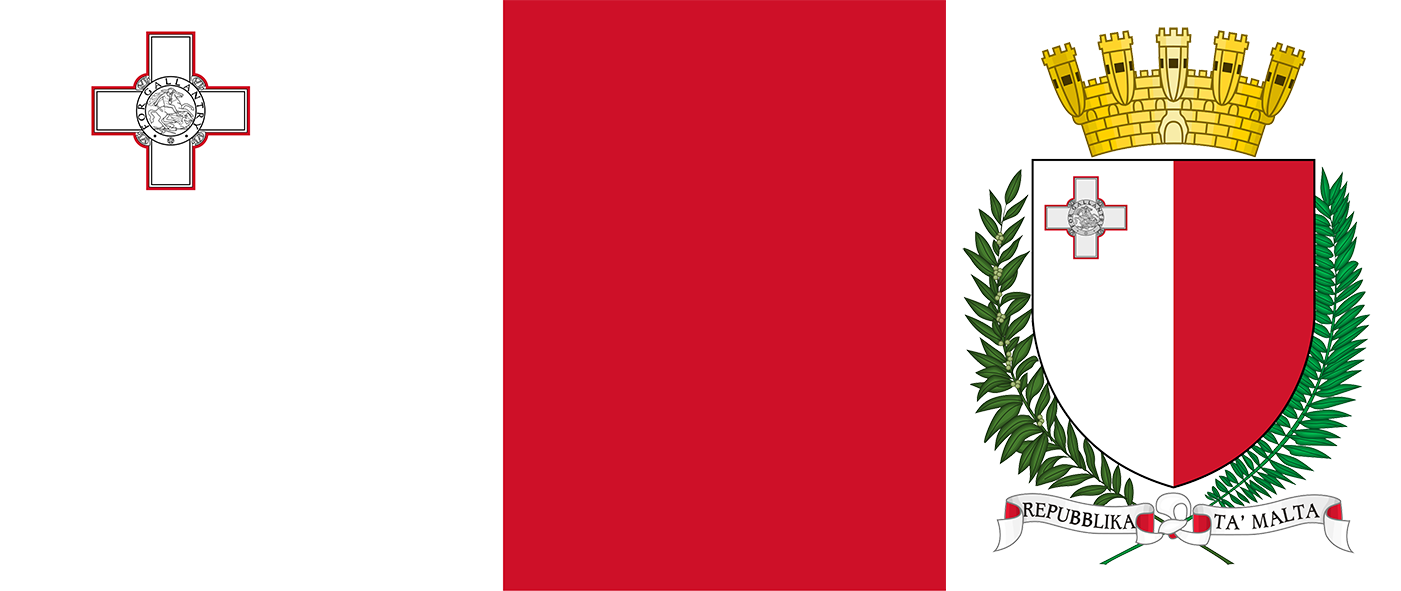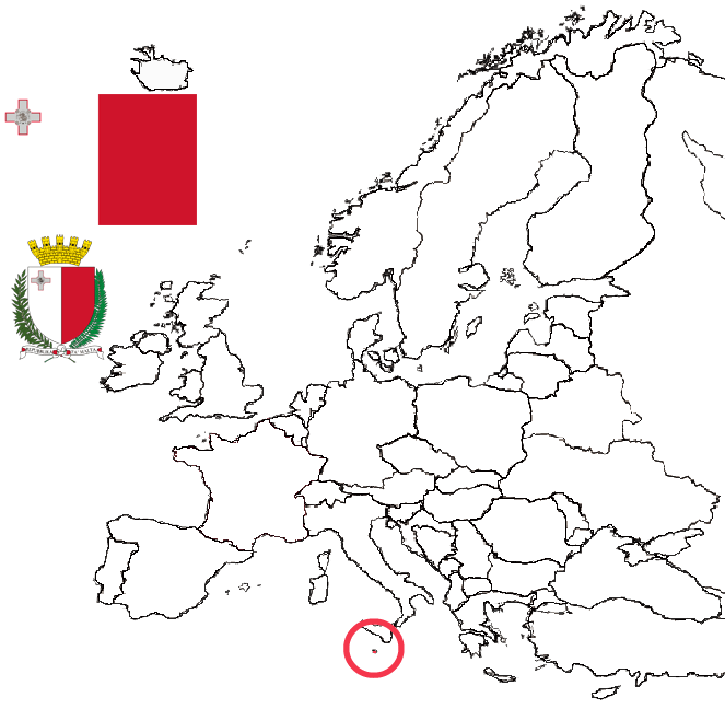FabulousFusionFood's Maltese Recipes Home Page
 The flag of Malta (left) and the coat of arms of Malta (right).
The flag of Malta (left) and the coat of arms of Malta (right).
Welcome to the summary page for FabulousFusionFood's Maltese recipes, part of Europe. This page provides links to all the Maltese recipes presented on this site, with 33 recipes in total.
This is a continuation of an entire series of pages that will, I hope, allow my visitors to better navigate this site. As well as displaying recipes by name, country and region of origin I am now planning a whole series of pages where recipes can be located by meal type and main ingredient. This page gives a listing of all the Indian recipes added to this site.
Malta, officially Repubblika ta' Malta (the Republic of Malta) is a Parliamentary Republic that's consists of an archipelago situated centrally in the Mediterranean, 93 km south of Sicily and 288 km north-east of Tunisia, with the Strait of Gibraltar. The country's official languages are Maltese and English. The capital and largest city is Valletta.
Maltese cuisine is predominantly Mediterranean in character, based on fresh seasonal locally available produce and seafood. Some popular Maltese recipes reflect Sicilian and Southern Italian though there are also traces of Moorish, Spanish, Berber, French and British influences.
These recipes, for the major part, originate in Malta. Otherwise they are fusion recipes with major Maltese influences.
Malta, officially the Republic of Malta (Repubblika ta' Malta in Maltese) is an island country in Southern Europe located in the Mediterranean Sea. It consists of an archipelago 80 km (50 mi) south of Italy, 284 km (176 mi) east of Tunisia, and 333 km (207 mi) north of Libya. The two official languages are Maltese and English. The country's capital is Valletta, which is the smallest capital city in the EU by both area and population. With a population of about 542,000 over an area of 316 km2 (122 sq mi), Malta is the world's tenth-smallest country by area and the ninth most densely populated. Various sources consider the country to consist of a single urban region, for which it is often described as a city-state.
 The image above shows Malta (in red) in relation to Europe. The Maltese
The image above shows Malta (in red) in relation to Europe. The Maltese
flag and coat of arms are inset.Malta has been inhabited since about 5900 BCE. Its location in the centre of the Mediterranean has historically given it great geostrategic importance, with a succession of powers having ruled the islands and shaped its culture and society. These include the Phoenicians, Carthaginians, Greeks, and Romans in antiquity; the Arabs, Normans, and Aragonese during the Middle Ages; and the Knights Hospitaller, French, and British in the modern era. Malta came under British rule in the early 19th century and served as the headquarters for the British Mediterranean Fleet. It was besieged by the Axis powers during World War II and was an important Allied base for North Africa and the Mediterranean. Malta achieved independence in 1964, and established its current parliamentary republic in 1974. It has been a member state of the Commonwealth of Nations and the United Nations since independence; it joined the European Union in 2004 and the eurozone monetary union in 2008.
Malta's long history of foreign rule and close proximity to both Europe and North Africa have influenced its art, music, cuisine, and architecture. Malta has close historical and cultural ties to Italy and especially Sicily; between 62 and 66 percent of Maltese people speak or have significant knowledge of the Italian language, which had official status from 1530 to 1934. Malta was an early centre of Christianity, and Catholicism is the state religion, although the country's constitution guarantees freedom of conscience and religious worship.
The English name Malta derives from Italian and Maltese Malta, from medieval Arabic Māliṭā (مَالِطَا), from classical Latin Melita, from latinised or Doric forms of the ancient Greek Melítē (Μελίτη) of uncertain origin. The name Melítē—shared by the Croatian island Mljet in antiquity—literally means 'place of honey' or 'sweetness', derived from the combining form of méli (μέλι, 'honey' or any similarly sweet thing) and the suffix -ē (-η). The ancient Greeks may have given the island this name after Malta's endemic subspecies of bees. Alternatively, other scholars argue for derivation of the Greek name from an original Phoenician or Punic Maleth (𐤌𐤋𐤈, mlṭ), meaning 'haven' or 'port' in reference to the Grand Harbour and its primary settlement at Cospicua following the sea level rise that separated the Maltese islands and flooded its original coastal settlements in the 10th century BCE. The name was then applied to all of Malta by the Greeks and to its ancient capital at Mdina by the Romans.
A number of grapes are endemic to Malta, including Girgentina and Ġellewża. There is a strong wine industry, with significant production of wines using these native grapes, as well as locally grown grapes of other more common varietals. A number of wines have achieved Protected Designation of Origin, with wines produced from grapes cultivated in Malta and Gozo designated as 'DOK' wines, that is Denominazzjoni ta' l-Oriġini Kontrollata.
This is a continuation of an entire series of pages that will, I hope, allow my visitors to better navigate this site. As well as displaying recipes by name, country and region of origin I am now planning a whole series of pages where recipes can be located by meal type and main ingredient. This page gives a listing of all the Indian recipes added to this site.
Malta, officially Repubblika ta' Malta (the Republic of Malta) is a Parliamentary Republic that's consists of an archipelago situated centrally in the Mediterranean, 93 km south of Sicily and 288 km north-east of Tunisia, with the Strait of Gibraltar. The country's official languages are Maltese and English. The capital and largest city is Valletta.
Maltese cuisine is predominantly Mediterranean in character, based on fresh seasonal locally available produce and seafood. Some popular Maltese recipes reflect Sicilian and Southern Italian though there are also traces of Moorish, Spanish, Berber, French and British influences.
These recipes, for the major part, originate in Malta. Otherwise they are fusion recipes with major Maltese influences.
Malta, officially the Republic of Malta (Repubblika ta' Malta in Maltese) is an island country in Southern Europe located in the Mediterranean Sea. It consists of an archipelago 80 km (50 mi) south of Italy, 284 km (176 mi) east of Tunisia, and 333 km (207 mi) north of Libya. The two official languages are Maltese and English. The country's capital is Valletta, which is the smallest capital city in the EU by both area and population. With a population of about 542,000 over an area of 316 km2 (122 sq mi), Malta is the world's tenth-smallest country by area and the ninth most densely populated. Various sources consider the country to consist of a single urban region, for which it is often described as a city-state.
 The image above shows Malta (in red) in relation to Europe. The Maltese
The image above shows Malta (in red) in relation to Europe. The Malteseflag and coat of arms are inset.
Malta's long history of foreign rule and close proximity to both Europe and North Africa have influenced its art, music, cuisine, and architecture. Malta has close historical and cultural ties to Italy and especially Sicily; between 62 and 66 percent of Maltese people speak or have significant knowledge of the Italian language, which had official status from 1530 to 1934. Malta was an early centre of Christianity, and Catholicism is the state religion, although the country's constitution guarantees freedom of conscience and religious worship.
The English name Malta derives from Italian and Maltese Malta, from medieval Arabic Māliṭā (مَالِطَا), from classical Latin Melita, from latinised or Doric forms of the ancient Greek Melítē (Μελίτη) of uncertain origin. The name Melítē—shared by the Croatian island Mljet in antiquity—literally means 'place of honey' or 'sweetness', derived from the combining form of méli (μέλι, 'honey' or any similarly sweet thing) and the suffix -ē (-η). The ancient Greeks may have given the island this name after Malta's endemic subspecies of bees. Alternatively, other scholars argue for derivation of the Greek name from an original Phoenician or Punic Maleth (𐤌𐤋𐤈, mlṭ), meaning 'haven' or 'port' in reference to the Grand Harbour and its primary settlement at Cospicua following the sea level rise that separated the Maltese islands and flooded its original coastal settlements in the 10th century BCE. The name was then applied to all of Malta by the Greeks and to its ancient capital at Mdina by the Romans.
Maltese Cuisine:
Maltese cuisine shows strong Sicilian and Italian influences as well as influences of English, Spanish, Maghrebin and Provençal cuisines. A number of regional variations can be noted as well as seasonal variations associated with the seasonal availability of produce and Christian feasts (such as Lent, Easter and Christmas). Food has been important historically in the development of a national identity in particular the traditional fenkata (i.e., the eating of stewed or fried rabbit). Potatoes are a staple of the Maltese diet as well.A number of grapes are endemic to Malta, including Girgentina and Ġellewża. There is a strong wine industry, with significant production of wines using these native grapes, as well as locally grown grapes of other more common varietals. A number of wines have achieved Protected Designation of Origin, with wines produced from grapes cultivated in Malta and Gozo designated as 'DOK' wines, that is Denominazzjoni ta' l-Oriġini Kontrollata.
The alphabetical list of all the Maltese recipes on this site follows, (limited to 100 recipes per page). There are 33 recipes in total:
Page 1 of 1
| Aljota (Fish Soup) Origin: Malta | Kosksu bil-Ful (Couscous with Broad Beans) Origin: Malta | Quassatat with Ricotta Filling Origin: Malta |
| Bigilla (Broad Bean Dip) Origin: Malta | Kwarezimal (Maltese Lenten Cake) Origin: Malta | Qubbajt (Maltese Nougat) Origin: Malta |
| Bragoli (Maltese Beef Rolls) Origin: Malta | Kwarezimal (Almond Cakes) Origin: Malta | Ravjul (Maltese Ravioli) Origin: Malta |
| Brungiel Mimli (Stuffed Aubergine) Origin: Malta | Maltese Pastizzi Origin: Malta | Ross il-Forn (Baked Rice) Origin: Malta |
| Fenek Moqli (Fried Rabbit) Origin: Malta | Maltese Sauce Origin: Malta | Ruggata (Almond Barley Water Cordial) Origin: Malta |
| Figolli (Maltese Easter Biscuits) Origin: Malta | Minestra (Maltese Vegetable Soup) Origin: Malta | Spagetti biz-zalza tal-Qarnit (Spaghetti with Octopus Sauce) Origin: Malta |
| Ghagina tal-Isfoll (Pastizzi Dough) Origin: Malta | Pastizzi ta' l-Incov (Anchovy Pastizzi) Origin: Malta | Stuffat Tal-Fenek (Rabbit Stew) Origin: Malta |
| Hobz (Maltese Bread) Origin: Malta | Pastizzi tal Pizelli (Pea Pastizzi) Origin: Malta | Stuffat Tal-Qarnit (Octopus Stew) Origin: Malta |
| Imqaret (Date Diamonds) Origin: Malta | Pudina tal-Hobz (Maltese Bread Pudding) Origin: Malta | Tarja Bil-Bajt (Fried Noodles) Origin: Malta |
| Imqarrun fil-Forn (Baked Macaroni) Origin: Malta | Qaghaq Tal L-Ghasel (Treacle Rings) Origin: Malta | Timpana (Baked Macaroni Pie) Origin: Malta |
| Kannoli tal-Irkotta (Ricotta-filled Cannelloni) Origin: Malta | Quassatat with Beef and Peas Filling Origin: Malta | Zalzett Malti (Maltese Sausages) Origin: Malta |
Page 1 of 1